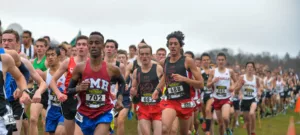By Mike Smith
1. Why can an athlete only compete in four events? I would think that you should be able to participate in as many things as you  can. Isn’t that good for the team?
can. Isn’t that good for the team?
I can’t speak to the initial reason for this but I can say I think it’s a good rule to have a limit on the amount of events an athlete can do. At the middle school level, the kids are learning track, and doing all the events over the season. This is probably a good idea to find out where their true interests lie. But at the HS level, part of the job is about training the athlete to compete. If we enter kids just simply because we can pick up a few points here and there, or enter them in events they aren’t trained to do, then that’s not a good coaching strategy with regard to development of an athlete or the potential for injury.
2. What is up with the pole vault? I get the rest of the events, run the fastest, jump the highest or farthest, throw something a long way but this one baffles me. Take a long pole and stick it in the ground and go over another pole the is up in the air. Where did this come from?
Again, I can’t speak to where this event came from. As for me, I don’t offer it as we don’t have the facility to practice and the inherent danger, need for a certified coach and the cost of the equipment is prohibitive. With that said, HS pole vault has come a long way. Right now we have an American HSer, who is ranked among the best in the world and recently (officially) set the WR for under 20, at just over 19 feet!
3. Speaking of the pole vault, shouldn’t they be wearing helmets? That is a long way up in the air and therefore a long way down. Helmets please!
As for helmets, the only answer is yes, they should. My understanding is there is an argument over the design of helmets with two different prototypes available, both arguing their’s is the better design. The more safety in this event the better.
 4.There seems to be a lot of rules for the relay events. If you drop the baton are you disqualified? In or out of the pass-the-baton area (pretty technical term there) and there are things that happen including being disqualified. That seems pretty harsh.
4.There seems to be a lot of rules for the relay events. If you drop the baton are you disqualified? In or out of the pass-the-baton area (pretty technical term there) and there are things that happen including being disqualified. That seems pretty harsh.
The rules can seem to be difficult to understand to the lay-person, similar to the rules of rugby for someone who hasn’t played the game. However, the rules are pretty clear and the onus is on the coaches to coach the relays properly. The concept of the pass having to happen between the triangles of the 20 meter hand-off zone is pretty simple and clear, it just has to be taught. Many times coaching relays and baton passing is put on the back burner in favor of “real” training, but done correctly, both can be accomplished at the same time.
5. Another relay question…why are there four runners in the relay? Why not two or three or six?
I think we can all agree that we have to have some standard for the amount of relay entrants. Obviously a team with 6 kids vs. a team with 2 wouldn’t be fair. But maybe you could have relays with up to four entrants, and if a team wanted to run less they could.
6. How come only the top six finishers score points? I think the top ten makes sense. That seems like a good cut off, you made the top 10! What other sport rewards the top six?
top 10! What other sport rewards the top six?
Scoring is determined by the number of teams that compete at a meet. With two teams they score one more place than the number of teams (so three.) This is the way it works up to 6 teams entered where the standard is set at six. There are provisions for scoring up to 8 but 6 is the standard. I think ten would be too many in most cases as it’s only at the big meets that there are ten or more athletes entered in events. Not sure the tenth (and last) competitor in an event makes sense to award points to.
7. Who picks the order of the events? It seems that at the state meet, they are in the same order every year. Let’s mix it up, have the coaches get to pick the order, lots of strategy potential.
The order of events is standard, however the games committee has the latitude to change the order of events, if desired or warranted. I have the last remaining dirt track used for HS meets in the state and we have a non-traditional meet schedule because we do not offer certain events due to the constraint of our track. We also offer some non-traditional events such as the sprint medley relay and distance medley relay. I do like the idea of mixing up the order of events which might allow for athletes to arrange their workloads differently but getting the majority to over-rule the standard would likely be difficult.
 8. Do the coaches know what the score is during a track meet? I have no idea what the score is or how various teams are doing. Where is the scoreboard?
8. Do the coaches know what the score is during a track meet? I have no idea what the score is or how various teams are doing. Where is the scoreboard?
Some coaches are very good at calculating the score of a meet as it goes along. I’m terrible at it and can’t even do it for cross country, which would be much easier. It’s been talked about with regard to getting the crowd into it. That knowing the score, and if in the final events it’s close, would be better for spectators and the sport in general. I know in the indoor track live stream announcing, we tried to keep tabs on that and inform the viewership when it was close.
9. Why is the track itself made out of asphalt, concrete or whatever that is? Even with the rubberized top, it is really hard. How about a nice grass track?
The idea of a grass track sounds delightful. But using this season as an example, we wouldn’t even have had a meet anywhere in the state at this point if tracks were grass. Rubberized tracks are faster, and can be standardized when the track is installed, unlike the other “natural” tracks. We are down to the wire prepping our track for this Saturday’s meet. The “all weather” tracks are called that for a reason . No fuss. No muss.
10. Why do the throwers have to throw whatever they are throwing into a certain area? If you don’t throw it straight, it does not go as far and that should be your punishment for non-accuracy. I also used the word throw three times in the same sentence, which is awesome.
Throwing is about technique, proper form, and correct mechanics. Teaching these qualities is the job of the athlete’s coaches. We’re not really talking about accuracy here, if that was true, it would be more like darts, with more points awarded for being closer to the target. If a kid uses correct mechanics and good form, the implement usually falls within the sector no problem. As mentioned in the replies, the difficulty for officials in measuring throws, not to mention the safety concerns to officials, participants and spectators.
I am not the foremost authority on track and field in the state by any means, but have been around a while so my perspective is likely more aged than most. The rules/standards are not only confusing for fans new to the sport, but we always have new coaches that have to “learn” this stuff as they go as well.











